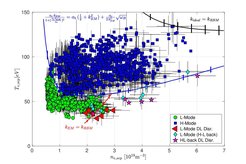Turbulence at the outermost plasma edge sets limits for plasma regime in tokamaks
Future fusion reactors should be operated at the highest possible plasma density. However, the maximum achievable density is limited by turbulent processes.
The fusion performance of a reactor is largely determined by the plasma density. This is also an important parameter for the power dissipation of the fusion plasma. In both cases, one would like to achieve densities as high as possible.

Measured pairs of electron temperature and density at the separatrix for L-mode (green) and H-mode (blue) plasmas in ASDEX Upgrade. The other symbols describe unstable states. The solid lines represent boundary regions that can be derived from turbulence equations.
Experimental investigations at ASDEX Upgrade have now shown that the density at the plasma edge is limited by turbulent processes.
The graph shows measured pairs of electron temperature and density at the separatrix, the outermost closed magnetic flux surface. The solid lines describe boundaries imposed by turbulence. Specifically, three boundaries were derived from the turbulence governing equations. The transition from L- to H-mode plasmas is reached when shearing of the plasma flow effectively dampens turbulent transport (blue line). The density limit of L-mode plasmas is described by the transition from electrostatic to electromagnetic turbulence (red line). Furthermore, ideal magnetohydrodynamics constrains the simultaneous attainment of high density and high temperature for H-modes (black line).
The paper can be found here: https://iopscience.iop.org/article/10.1088/1741-4326/ac0412
